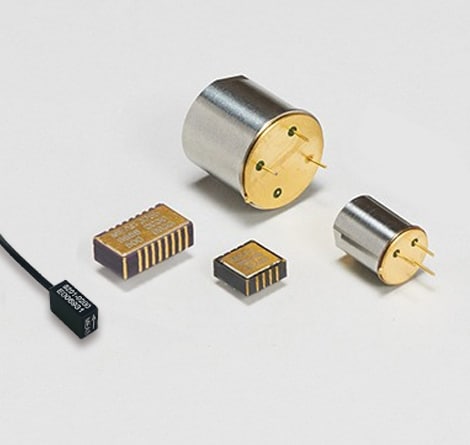
Piezoelectric Accelerometers
The most common AC-response accelerometers use piezoelectric elements for their sensing mechanism. Under acceleration, the seismic mass of the accelerometer causes the piezoelectric element to “displace” a charge, producing an electrical output proportional to acceleration. Piezoelectric accelerometers are suitable for dynamic measurements.

AC Response

Dynamic Measurements

High Frequency to 15kHz
AC RESPONSE ACCELEROMETER TYPES
Charge Mode Piezoelectric
The majority of the piezoelectric sensors are based on lead zirconate titanate ceramics (PZT) which offer very wide temperature range, broad dynamic range, and wide bandwidth (usable to >10kHz). When housed in a hermetic, welded metal case, a charge mode accelerometer can be considered one of the most durable sensors because of its ability to tolerate hostile environmental conditions.
Due to its high impedance characteristics, a charge mode device must be used with a low-noise shielded cable, preferably in a coaxial configuration. These noise treated cables are commonly available from the sensor manufacturers.
A charge amplifier is generally used to interface with charge mode accelerometers to avoid problems associated with parallel cable capacitance. With a modern charge amplifier, the broad dynamic range (>120 dB) of the charge mode sensors can be easily realized. Due to the wide operating temperature range of piezoelectric ceramics, some charge mode devices can be used from -200°C to +640°C and beyond. They are especially suitable for use in vibration measurements at temperature extremes, such as in turbine engine monitoring.

Voltage Mode Piezoelectric
The other type of piezoelectric accelerometer provides a voltage output instead of charge. This is accomplished by incorporating the charge amplifier inside the housing of the accelerometer.
2 Wire Mode: Power/Signal, Ground
The 2-wire mode is also known as Integral Electronics Piezo Electric (IEPE). IEPE is most popular due to its convenient coaxial (two-wire) configuration in which the AC signal is superimposed on the DC power line. A blocking capacitor is needed to remove the DC bias from the sensor signal output. Many modern signal analyzers provide the IEPE/ICPTM input option which allows a direct interface to IEPE accelerometers. If the IEPE power option is not available, a signal conditioner/power supply with constant current power is required to interface with this type of device.
3 Wire Mode: Signal, Ground, Power
The 3-wire mode device requires a separate DC power supply line for proper operation. Unlike a charge mode device that only contains ceramic sensing element(s), voltage mode device includes a microelectronic circuit which limits the operating temperature of the device to the maximum operating temperature of the electronics, typically at +125°C.
Due to the exceptionally wide dynamic range in piezoelectric ceramic elements, charge mode accelerometers are most flexible in terms of scalability because the system full scale range can be adjusted from the remote charge amplifier at the user’s command. Voltage mode devices, on the other hand, have their full scale range pre-determined by the internal amplifier at the factory and cannot be altered. Piezoelectric accelerometers are available in very small footprint. They are ideally suited for dynamic measurements in lightweight structures.

Applications
- Condition monitoring
- Automotive safety testing
- High speed rail and mass transit
- Flight testing
- Seismic and structure monitoring
- Wind turbines
